INTRODUCTION
This project aims to develop the branding, strategy and prototypes for a start-up jewellery business. Best known as a landscape architect, Patrick Collins is looking to pursue his other creative passion, jewellery making. Still at the embryonic stages of his journey, this project is responsible for creating the branding for his jewellery, which draws influence from the natural world, architectural forms and sustainable materials.
I aim to create a comprehensive and cohesive brand that reflects the values of both jewellery and designer, with branding attributes that lend themselves effectively to both digital and print forms.
RESEARCH
The Role of Brands in Society
✺
The Conscious Consumer
The ethics and sustainability of goods and services are becoming increasingly scrutinised by today’s consumer, who ‘wants the full story of how their product was made’ (Mageean, 2020 [online]). There is an increasing demand for more ethical jewellery, with data revealing ‘ethical jewellery searches are up by 60%’ (Lyst, 2020 [online]). Brands must understand the importance of sustainability to modern consumers, and implement the new business model of being not just profitable, but ‘socially responsible and environmentally conscious’ (Wheeler, 2012:48). A brand’s responsibility is communicated through its branding decisions. By promoting their values and sharing information about their practices, brands can give the consumer control to make an informed and conscious choice. Jewellery brands can demonstrate this transparency by communicating to their audience honestly, sharing how materials are sourced and extracted, how the piece was made and by whom.
✺
Jewellery & Ethics
Jewellery holds a symbolic and historic relevance across cultures, a physical token of landmark occasions and celebrations, as well as an expression of our personality or style. However, it is important to consider what cost our jewellery choices have ethically. As jewellery purchases are often a highly emotional and financial investment, the truth of the industry’s unethical and environmentally damaging impact is all the more uncomfortable. The jewellery industry is significantly unregulated, and the sourcing of precious materials devastates natural habitats in often the poorest of countries. Not only this, but there is also the human cost of child exploitation, violence and loss of life from mining disasters (Human Rights Watch, 2018 [online]).
✺
Small Businesses
One way of improving jewellery’s ethical blind spot is to shop with small businesses and independent artists, due to their small-scale production and willingness to be transparent compared to larger brands. Independents are also able to ‘respond with greater flexibility and develop deeper personal relationships’ with customers (Dimensional Research, 2019). With the rise in online shopping, platforms like Etsy act as a ‘shop front for artists to sell their work’ (MoMa, 2021 [online]) and allows the opportunity for small businesses and artists to promote themselves, manage their business and reach consumers directly. Digital media is accessible to businesses of all sizes, and can be used ‘as a platform for conveying information, shaping brand identity, and building customer relationships’ (McKinsey, 2014 [online]).


UNDERSTANDING THE DESIGNER
I established the following key points through liaising with the designer:
✺
The designer is still establishing a style, so his designs are subject to change
✺
Jewellery is inspired by nature, geometrical and architectural forms
✺
There is currently no intention to make the jewellery business a full-time commitment, it is more of a passion project, with making sales a bonus
✺
Each piece is a hand-crafted one off, best described as Art or Studio jewellery
As the designer is still in the beginner stages of his jewellery making, and is still establishing a style, I started by forming an understanding of the designer, his inspiration and what his aims for the jewellery business are. The designer sent over a few notes of initial thoughts, which helped me to establish where he is in his thinking for the business without me making suggestions prematurely. Further email and phone conversations will refine ideas and act as an opportunity to generate ideas with the designer.
I completed a SWOT analysis for the jewellery brand, based on client notes and research of the industry.
DEFINING TARGET AUDIENCE
When establishing the needs of the target consumer, I referred to Maslow’s Hierarchy of Needs. While jewellery is not definable as a basic need for survival, it can be applied to four out of the five segments of the hierarchy as psychological and self-fulfilment needs. I have decided to target my segment on the ‘Self-Actualisation’ stage, as the jewellery’s unique style lends itself more to creativity, and self-expression through dress. Targeted sub-segments ‘Esteem’ and ‘Love and Belonging’ also apply, as the jewellery will be
promoted through social media (esteem) and can be given as gifts (love and belonging).
SURVEY
I created a survey using Survey Monkey which I shared via my aunt's Facebook page, as it had the best potential to reach the target demographic this way. I also shared the survey amongst friends and peers to gain some responses from the secondary, Millennial consumer.
✺
Based on the jewellery’s current style, and the designer’s aims to sell through craft shows and art galleries, I have identified that the brand would appeal primarily to the ‘vibrant, empowered’ Gen X consumer who make up a large proportion of the population, have the spending power and are just as internet-savvy as the younger generations (Phelan, 2014). The jewellery also has the potential to appeal to Millennials, as this generation is actively demanding brand transparency, favouring sustainable brands and considering the environmental benefits of shopping independently. I conducted a survey that was shared via Facebook, targeting women aged 25-60. The survey findings support my initial thinking, and have confirmed that the jewellery’s primary characteristics are aligned with the target demographic’s preferences.






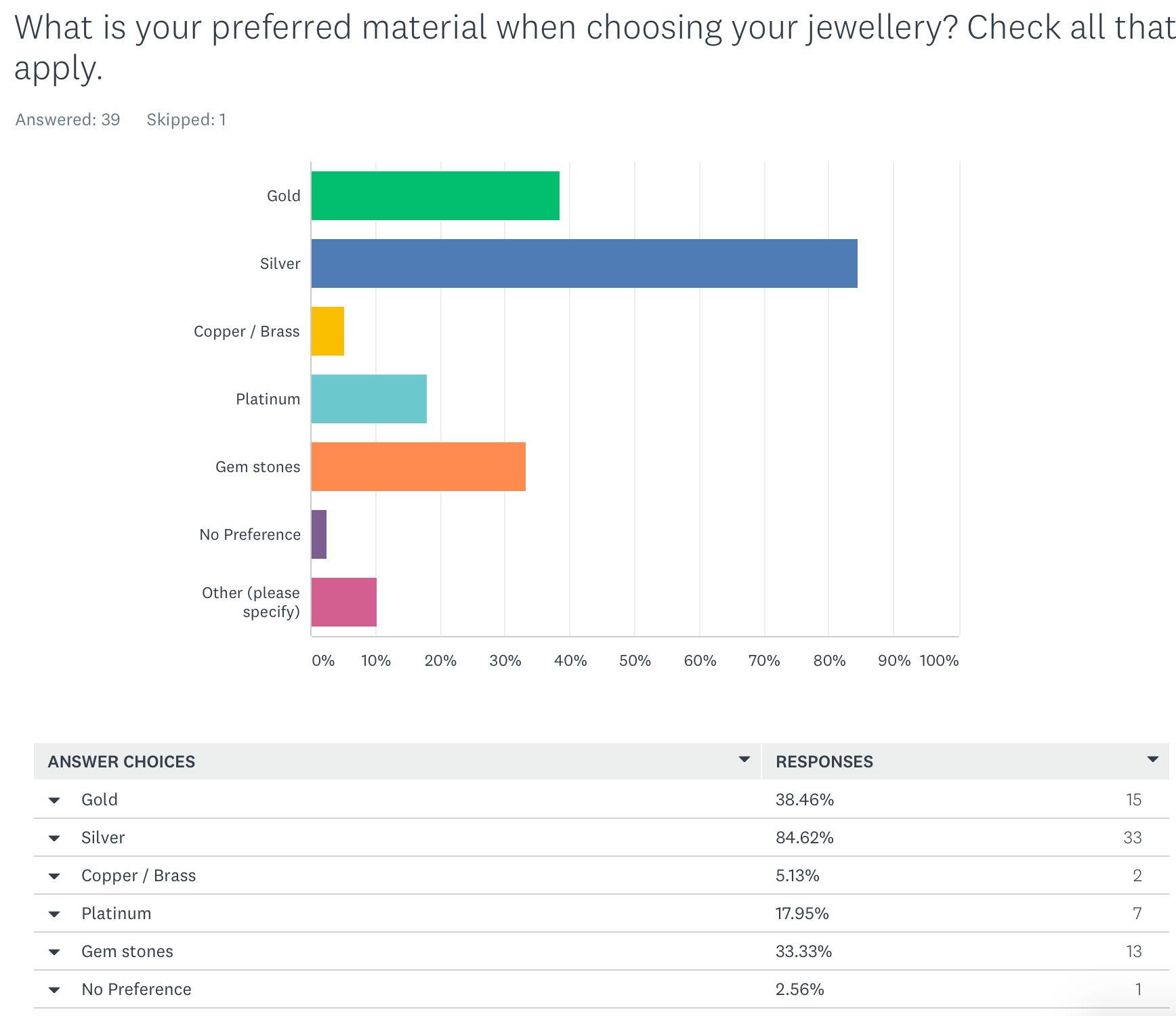




SURVEY FINDINGS


PERSONAS
Personas are ‘amalgams of multiple people who share similar goals, motivations, and behaviours’ (Saffer, 2010:107) and this information is gathered through researching the target user. I created personas by analysing my survey responses, noting similarities and reoccurring responses amongst Gen X and Millennial survey participants. With the Pareto Principle in mind, these two personas contextualise the 20% of consumers who would be buying 80% of the brand’s products (Forsey [online]) and therefore their habits and values must be considered throughout the project’s development.
PROJECT LIFE CYCLES
Having explored project life cycles, I now understand the practical steps that I must take in order to work professionally and effectively complete this project. Tailoring each stage to this project, I will refer to each of the four stages throughout. As is required during the Initiation and Planning stages, I have outlined a Project Plan, and begun considering risk management and quality assurance.


INFLUENCES / COMPETITORS / INSPIRATION
The jewellery market is incredibly saturated and diverse, from fine jewellery investments to cheaper and changeable fast fashion. Having looked at a broad range of different jewellery brands, I am focusing my search on those who identify as sustainable or ethical, and have similar values or product styles to the client.



I have maintained a Pinterest board throughout this project as a source of inspiration of various elements of this project; including photography, packaging and logo design.
BRAND DEVELOPMENT
This section covers the initial research and theory stage of the project's brand development.
For the complete design process, please visit the Design Process page.
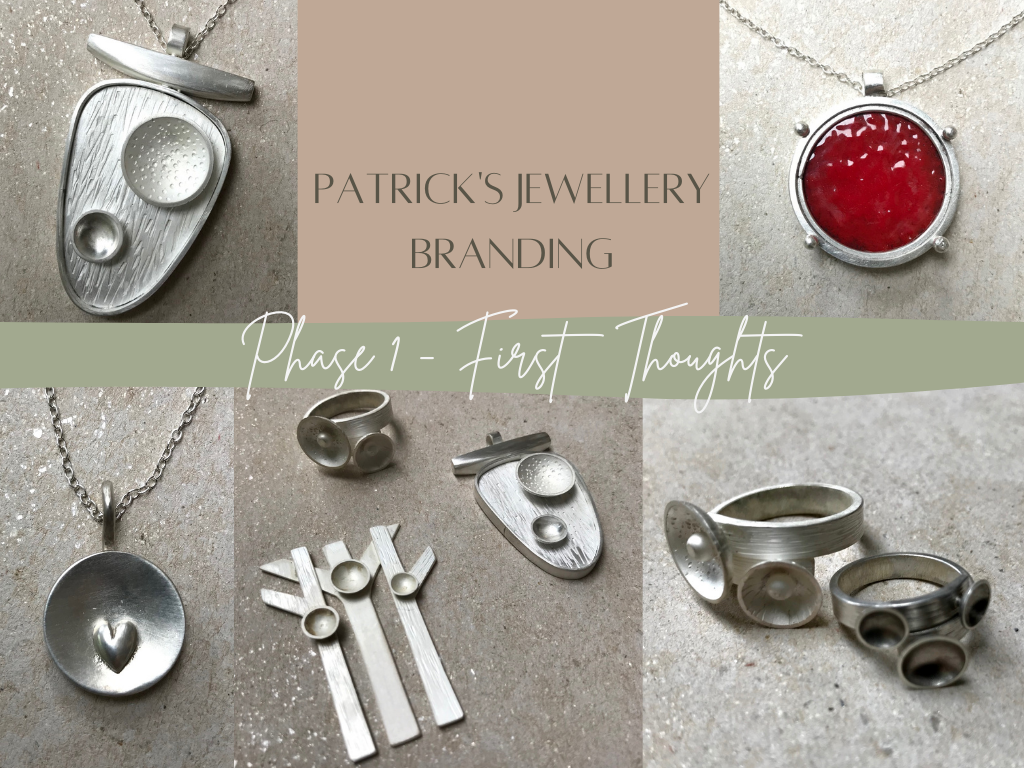









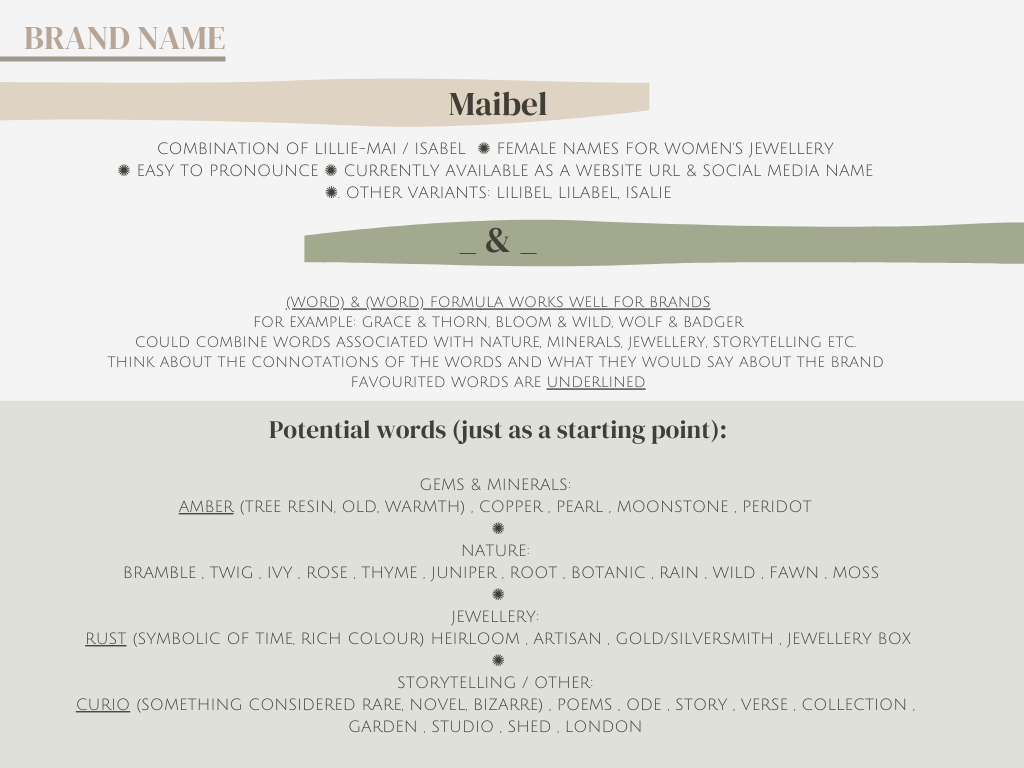

INITIAL THOUGHTS
Having got to know the client’s jewellery and thinking more clearly, I created a PDF document based on their notes, including initial competitor research, moodboards and name brainstorming, which was shared with the client in the early stages for feedback.
Iterative Design Process
In order to create a brand that tells the product’s story and appeals to the target audience, the Iterative Design process will be crucial. It is essential to adapt and evolve ideas throughout the design process, reflecting the knowledge I gain through in-depth research and analysis, such as client feedback, competitor research and theories (Chudley, 2012:4). Building a brand that listens to the needs of the target consumer and reflects the designer’s values will be vital to the success of the brand when it launches into the real world. Designing iteratively during the prototyping stage will also determine effective usability of the brand’s online interface.
BRAND IDEALS HONEYCOMB
Brand Ideals Honeycomb Analysis (Wheeler, 2012:29) - This framework will act as a reference point throughout the branding process, as well as considering future brand development such as marketing, communication and consistency.
NARRATIVE TRANSPORTATION THEORY
A brand identity is more than a name or a logo, it is a ‘holistic perception of your company’ (Fabrik, [online]). The most successful brands ‘create an emotional difference’ (Olins, 2013 [online]) and are able to generate joy or a human connection. The psychology of Narrative Transportation Theory has helped me to understand the effectiveness of storytelling when building a brand, suggesting that immersing ourselves in a story has the power to change our beliefs and behaviour (Lischer [online]). Narrative Transportation can be applied across marketing and branding, as telling a compelling brand story engages audiences and builds a loyal following who truly believe in your ethics and your products. Narrative Transportation incorporates ‘imaginative imagery and emotional involvement’ (Shrum, 2012:170), qualities I aim to incorporate into this jewellery brand, telling its story through visual devices such as text, photography, graphics and packaging.
ESTABLISHING BRAND STRATEGY
Working in alignment with business strategy, a Brand Strategy is born out of the values and culture of a brand, defining ‘positioning, differentiation, competitive advantage and a unique value proposition’ that reflects the consumer’s needs (Wheeler, 2012:12).
DEFINING BRAND IDENTITY

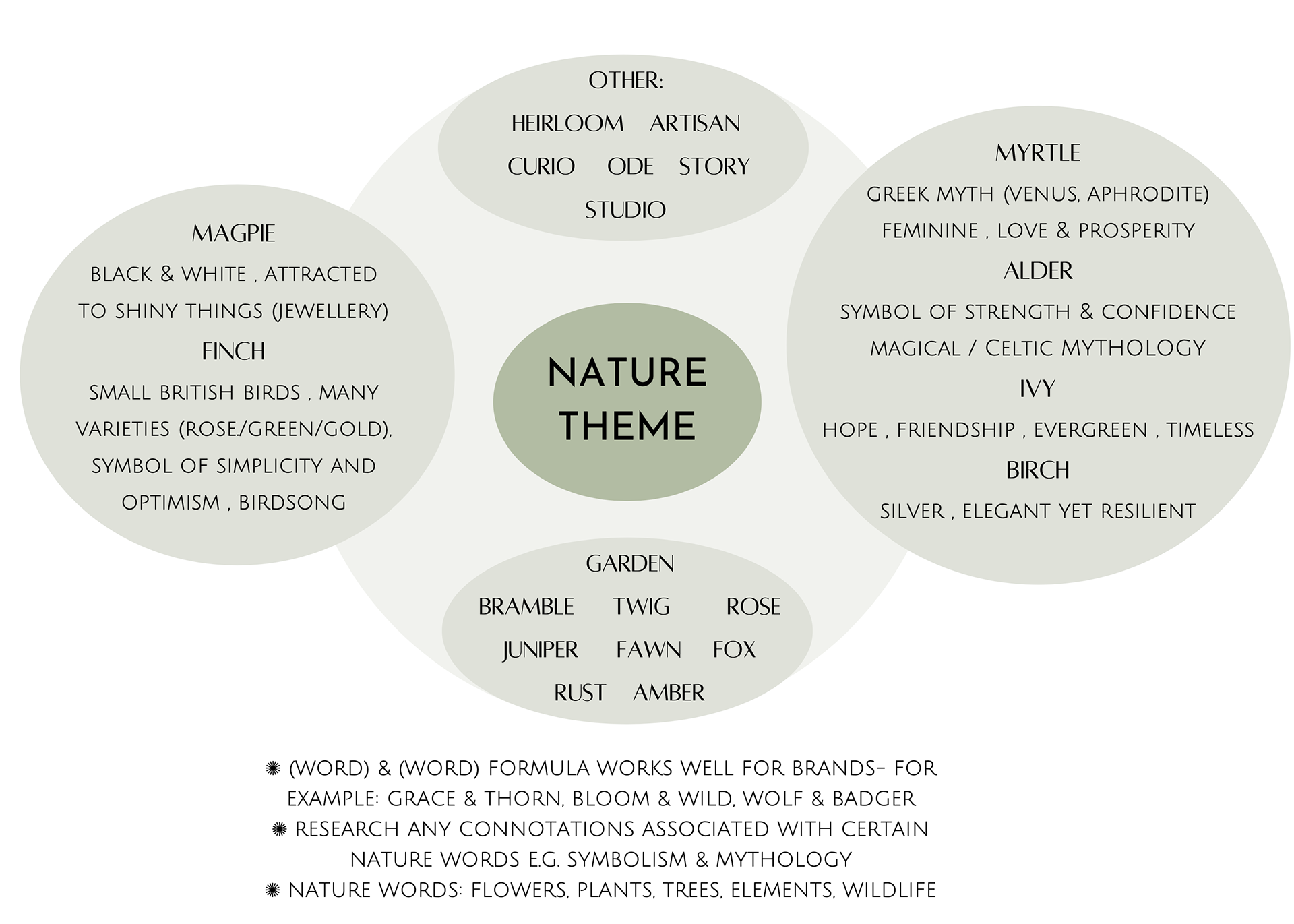
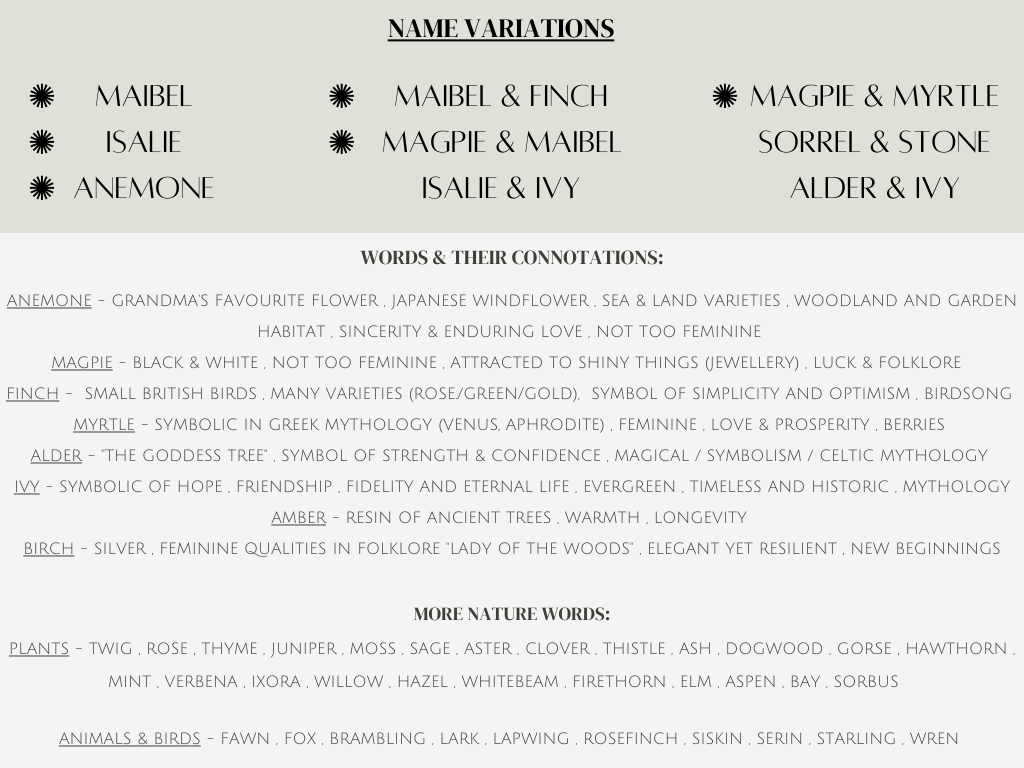
BRAND NAME DEVELOPMENT
It is not uncommon for jewellery brands, especially independent artists, to simply be named after the designer. However in this case, with the client being known and publicised as a landscape architect, and appearing several times at the RHS Chelsea Flower Show, he was keen to keep both lines of work separate, particularly as he will be continuing with his landscape design as his primary occupation.
When receiving feedback from the client, the use of his daughters’ names was most appealing, however this posed a challenge of creating words that sound good, read well and communicate the brand’s sustainability ethos. While nature words are highly evocative, and reflect the jewellery well, such words are often over-used in branding, particularly of small businesses, and pose the risk of being difficult to remember.
For each idea I had, I checked social media for existing companies using the name, and their availability as URLs. Nature words are used a lot across branding, and unsurprisingly several of the combinations I came up with ended up being taken on social media. These examples included Aspen & Bay, Mable & Rose.
With the anagrams came the risk of indirectly choosing an unusual word, so I also searched for these seemingly made up words to check that there was no negative connotations of the word, for example, does the word exist in another language or culture? If so, what does it mean? Does it have negative connotations that would conflict with the brand message?
When looking at nature words, I scoured the pages of several books in our family home, in search of words related to plants, wildlife and nature in general. Again, once I came across a word that had a ring to it and had potential, I would look a bit deeper into the meanings, to discover the symbolism and connotations, to see if there was anything in this research that would reveal something about the term that would strengthen (or weaken) its meaning as part of the brand. Nature holds so much symbolism, ancient folklore and mythology that it was interesting to discover more about the meaning of these words, which ultimately helped me to shortlist my findings.
I started the naming process by brainstorming nature words as a tribute to the natural forms that inspire the jewellery’s designs. I also created anagrams of the client’s daughters’ names, as this may appeal to the female target audience, and offered the potential to add a personal touch to the branding that could be incorporated into the brand story. The final name will be decided after further research has been conducted, and a logo will be drafted based on a combination of research and iterative designing.


MOODBOARDS
Moodboards are an effective way of creating an instant understanding between client and designer, and an opportunity to ‘explore the emotional landscape of a product’ (Saffer, 2010:149). I presented the client with a trio of moodboards in the early stages, which allowed me to identify what appeals to the client, and has the most potential to strongly communicate the brand. Moodboards will be refined and re-iterated based on client feedback and further research to produce the most cohesive brand identity.



TECHNICAL DEVELOPMENT
I aim to produce three core outcomes: Brand Guidelines, a website prototype and a packaging prototype.
Brand Guidelines
When producing brand assets, the majority of design work will require me to learn Adobe Illustrator and I will continue to gain proficiency of digital drawing in Procreate. I will use Lightroom and Photoshop during post-production of brand photography. The final presentation file will be created with InDesign.
Website
I will be creating a responsive prototype for the website using Adobe XD. As the client is still in the early stages of development, the monetary commitment of a live website is not necessary currently. When creating the actual website in the future, Squarespace will be used due to its versatility of facilitating both portfolio and e-commerce features.
Packaging
Creating recyclable packaging is of key importance to the client, and supports the brand’s aims at being an ethical small business. I will explore various sustainable options, including recyclable or ‘second life’ packaging (Arnold, 2009:39) which is functional, re-usable and attractive. I aim to learn how to create digital packaging mock-ups using Adobe Dimension, and a physical prototype may also be produced to establish the packaging’s size, tactile qualities and functionality.
FEEDBACK & REFLECTION











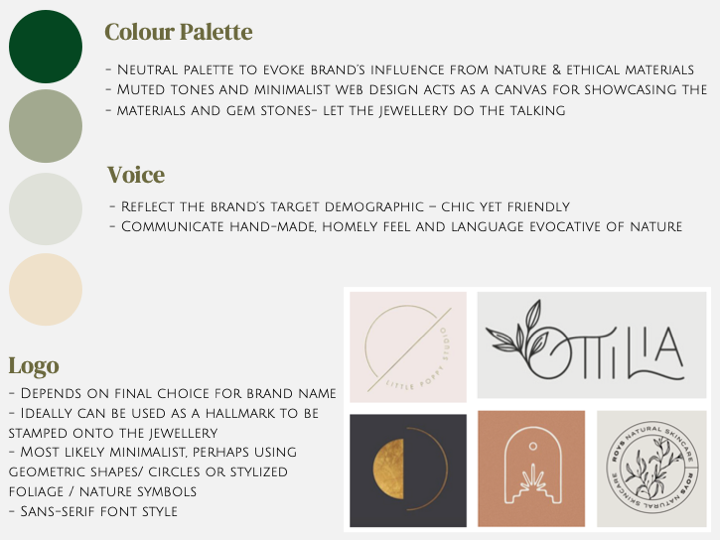

PEER CRITIQUE PRESENTATION
(FORMATIVE ASSESSMENT) - WEEK 5
I attended the course's peer critique session in Week 5 as part of the formative assessment. During this session I presented my idea and progress with the project so far.
This session was really helpful as it enabled me to gain feedback from my peers and the lecturer to gage if I was on the right tracks with the project, and to get people's thoughts, particularly regarding the brand's name and visual intentions.
Some encouraging feedback included:-
✺ Moodboards and personas successfully communicated ideas
✺ Methodical approach to the project with good research
✺ Naming process is clever and well thought through
Suggestions included:-
✺ Current colour palette could afford an additional colour- the shades of green are very similar and the beige colour could do with a darker accent, such as a burnt orange or brown
✺ Preference to shoot with a model if possible as it allows to demonstrate the jewellery's scale and can show it off in situe, styled correctly with the right clothes that will appeal to the demographic
CLIENT CORRESPONDENCE
Throughout the project I maintained a consistent dialogue with the designer, as it was important for me to be sure that the decisions I made maintained their expectations for the brand, as this branding will most likely be used in the near future when he launches his jewellery line. I regularly liaised with the designer over email and phone call and would keep him in the loop of developments with my project.
I have noted some general notes of correspondence with the client here that can be referred back to throughout the process:-
✺ Client likes the Japanese and Minimalist style
✺ Arts & Crafts, forged, hammer marks, all unique
✺ Metalwork & textures- silver more than gold, potentially copper
✺ Metalwork & textures- silver more than gold, potentially copper
✺ Likes the idea of soft coloured packaging e.g. light greens
✺ In an ideal world he would trade through art galleries, boutiques and trade shows e.g. Country Living, Spirit of Christmas
✺ Aim for 3-4 symbols of ethos/values
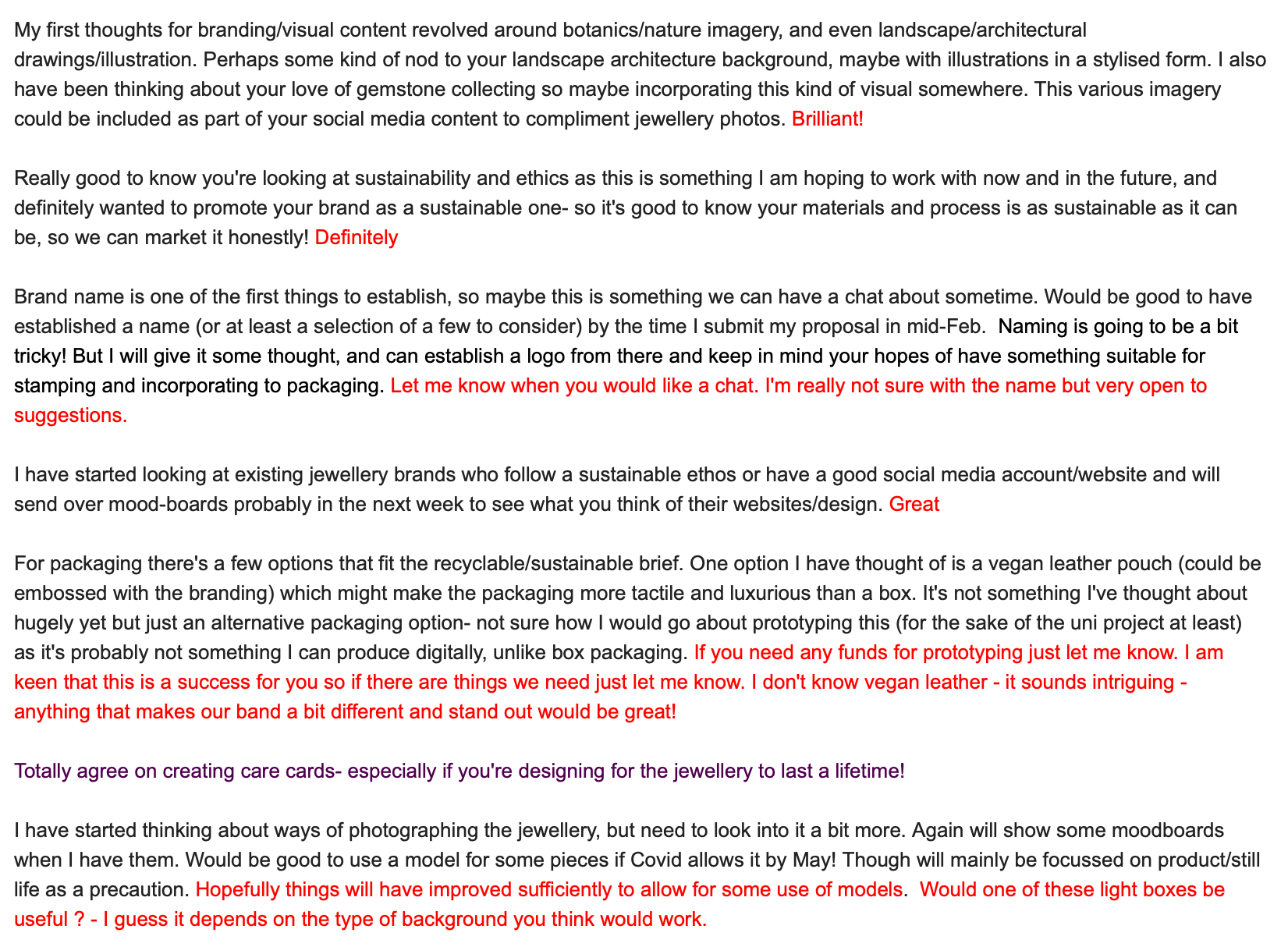


DESIGN PROCESS
For the full design process of this project, please click the button below.
